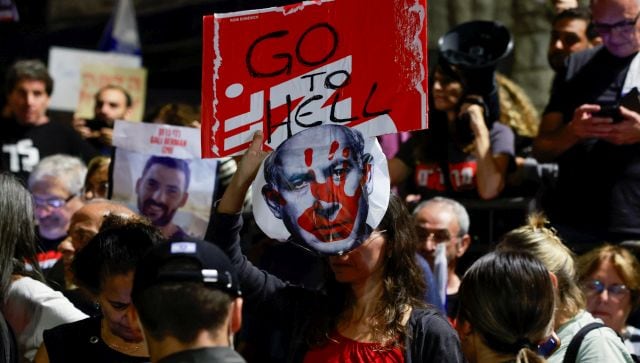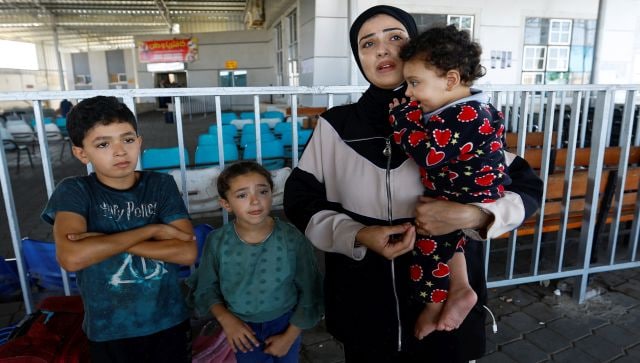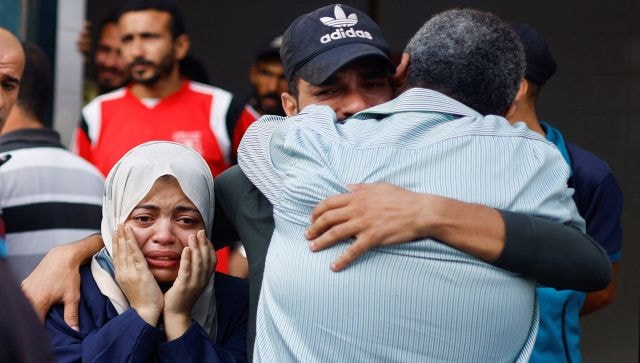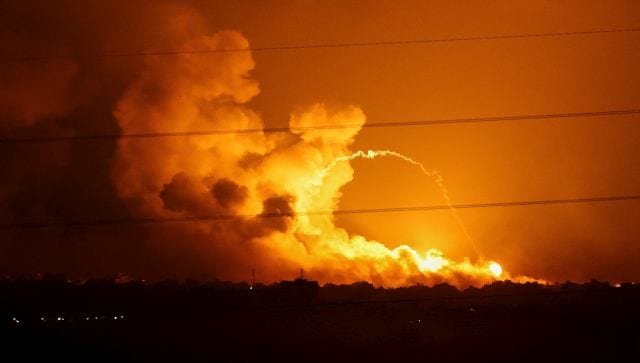The Israel-Hamas war has entered its second month. The Jewish nation has intensified its airstrikes in Gaza and its military tanks and soldiers are making advance in the enclave. More than 10,000 people, including 4,104 children have died, in the territory, according to the Hamas-run health ministry. Amid all this, there are growing calls for Israel to stop. The Arab world has called for a ceasefire; the United States is pressing to pause the assault on Gaza. Now Israeli prime minister Benjamin Netanyahu has said that Israel would consider
“tactical little pauses” in Gaza
fighting to facilitate the entry of aid or the exit of hostages, reports Reuters. However, he has turned down calls for a ceasefire during an interview with US television network ABC News. When questioned about the possibility of humanitarian pauses in fighting, the Israeli PM said that a general ceasefire would hamper his country’s war effort. “As far as tactical little pauses – an hour here, an hour there – we’ve had them before. I suppose we’ll check the circumstances in order to enable goods, humanitarian goods to come in, or our hostages, individual hostages, to leave,” Netanyahu told ABC News on Monday. [caption id=“attachment_13357722” align=“alignnone” width=“640”] Protesters gather against Israeli Prime Minister Benjamin Netanyahu near his residence in Jerusalem, as the conflict between Israel and Hamas continues, on 4 November. Reuters[/caption] How are humanitarian pauses different from a ceasefire? Why has Netanyahu and his biggest ally, the US, rejected the latter? We explain. What are ‘humanitarian pauses’? The terms “humanitarian pause” or “ceasefire” are not defined in international law. Those who find themselves embroiled in armed conflicts are not required to adopt such measures as per the law, according to Chatham House, a London-based British think tank. A pause then is a temporary stop in the fighting, which enables other things to happen. This is purely for humanitarian reasons. Pauses can be confined to a specific area to allow humanitarian activities. They are usually in force for a specific period; they can last as little as a few hours. Samir Puri, a visiting lecturer on war studies at King’s College London, was quoted as saying by Al-Jazeera, “A humanitarian pause would effectively be a truce to allow passage of aid or displaced people.” According to Chatham House, the adoption of a humanitarian pause can promote obligations under international humanitarian law. These include the evacuation of the wounded and sick, or facilitating the rapid and unimpeded passage of humanitarian relief. “…we’ve already seen a couple of pauses in at least the Israeli fighting when hostages – the four hostages that have been released were moving out of Gaza and back into Israel,” said Ivo Daalder, former US ambassador to NATO, told NPR. On 2 November, hundreds of foreign nationals and dozens of seriously injured Palestinians were allowed to
leave Gaza
after more than three weeks under siege. [caption id=“attachment_13357752” align=“alignnone” width=“640”]
Protesters gather against Israeli Prime Minister Benjamin Netanyahu near his residence in Jerusalem, as the conflict between Israel and Hamas continues, on 4 November. Reuters[/caption] How are humanitarian pauses different from a ceasefire? Why has Netanyahu and his biggest ally, the US, rejected the latter? We explain. What are ‘humanitarian pauses’? The terms “humanitarian pause” or “ceasefire” are not defined in international law. Those who find themselves embroiled in armed conflicts are not required to adopt such measures as per the law, according to Chatham House, a London-based British think tank. A pause then is a temporary stop in the fighting, which enables other things to happen. This is purely for humanitarian reasons. Pauses can be confined to a specific area to allow humanitarian activities. They are usually in force for a specific period; they can last as little as a few hours. Samir Puri, a visiting lecturer on war studies at King’s College London, was quoted as saying by Al-Jazeera, “A humanitarian pause would effectively be a truce to allow passage of aid or displaced people.” According to Chatham House, the adoption of a humanitarian pause can promote obligations under international humanitarian law. These include the evacuation of the wounded and sick, or facilitating the rapid and unimpeded passage of humanitarian relief. “…we’ve already seen a couple of pauses in at least the Israeli fighting when hostages – the four hostages that have been released were moving out of Gaza and back into Israel,” said Ivo Daalder, former US ambassador to NATO, told NPR. On 2 November, hundreds of foreign nationals and dozens of seriously injured Palestinians were allowed to
leave Gaza
after more than three weeks under siege. [caption id=“attachment_13357752” align=“alignnone” width=“640”] Palestinians, including foreign passport holders, wait at Rafah border crossing after evacuations were suspended following an Israeli strike on an ambulance, in Rafah in the southern Gaza Strip, on 5 November. Reuters[/caption] How is a pause different from a ceasefire? The key difference between a pause and a ceasefire is the purpose of suspension – whether it is to allow a specific humanitarian activity to be conducted or whether it is a generalised suspension of hostilities. A ceasefire means that the fighting between two warring sides ceases or stops. It comes into force after an agreement by the parties involved and often involves a formal political process with promises to de-escalate the conflict. This can entail withdrawing weapons and repositioning troops, according to a report in Al-Jazeera. A ceasefire usually covers the complete geographical area on which the war is being waged. It may lead to a permanent settlement, the report says. In the case of the Israel-Hamas war, a ceasefire would involve the withdrawal of tanks and troops from Gaza and a promise by Hamas to release all hostages. [caption id=“attachment_13357802” align=“alignnone” width=“640”]
Palestinians, including foreign passport holders, wait at Rafah border crossing after evacuations were suspended following an Israeli strike on an ambulance, in Rafah in the southern Gaza Strip, on 5 November. Reuters[/caption] How is a pause different from a ceasefire? The key difference between a pause and a ceasefire is the purpose of suspension – whether it is to allow a specific humanitarian activity to be conducted or whether it is a generalised suspension of hostilities. A ceasefire means that the fighting between two warring sides ceases or stops. It comes into force after an agreement by the parties involved and often involves a formal political process with promises to de-escalate the conflict. This can entail withdrawing weapons and repositioning troops, according to a report in Al-Jazeera. A ceasefire usually covers the complete geographical area on which the war is being waged. It may lead to a permanent settlement, the report says. In the case of the Israel-Hamas war, a ceasefire would involve the withdrawal of tanks and troops from Gaza and a promise by Hamas to release all hostages. [caption id=“attachment_13357802” align=“alignnone” width=“640”] Palestinians react at a hospital, in the aftermath of Israeli strikes on houses, amid the ongoing conflict in the central Gaza Strip, on 5 November. Reuters[/caption] Which countries have called for a ceasefire? On Monday, the heads of several major United Nations bodies made a united call for a
humanitarian ceasefire
in Gaza. The 18 signatories include Volker Turk, the UN High Commissioner for Human Rights, the head of the World Health Organization, Tedros Adhanom Ghebreyesus, and UN aid chief Martin Griffiths, reports Reuters. “An entire population is besieged and under attack, denied access to the essentials for survival, bombed in their homes, shelters, hospitals and places of worship. This is unacceptable,” they said in a joint statement. Russia has been calling for a ceasefire since the conflict broke out on 7 October following the Hamas attack on Israel.
The Arab world
has been demanding an immediate ceasefire in Gaza. Jordan’s foreign minister Ayman Safadi said on Sunday that Arab countries want an immediate ceasefire, saying “the whole region is sinking in a sea of hatred that will define generations to come.” However, the US has rejected calls for a ceasefire.
Palestinians react at a hospital, in the aftermath of Israeli strikes on houses, amid the ongoing conflict in the central Gaza Strip, on 5 November. Reuters[/caption] Which countries have called for a ceasefire? On Monday, the heads of several major United Nations bodies made a united call for a
humanitarian ceasefire
in Gaza. The 18 signatories include Volker Turk, the UN High Commissioner for Human Rights, the head of the World Health Organization, Tedros Adhanom Ghebreyesus, and UN aid chief Martin Griffiths, reports Reuters. “An entire population is besieged and under attack, denied access to the essentials for survival, bombed in their homes, shelters, hospitals and places of worship. This is unacceptable,” they said in a joint statement. Russia has been calling for a ceasefire since the conflict broke out on 7 October following the Hamas attack on Israel.
The Arab world
has been demanding an immediate ceasefire in Gaza. Jordan’s foreign minister Ayman Safadi said on Sunday that Arab countries want an immediate ceasefire, saying “the whole region is sinking in a sea of hatred that will define generations to come.” However, the US has rejected calls for a ceasefire.
What is the US’s take? US secretary of state Antony Blinken, who is on his second visit to West Asia since the war began, met with Arab foreign ministers in Jordan on Saturday after talks in Israel with Prime Minister Benjamin Netanyahu, who insisted there could be no temporary cease-fire until all hostages held by Hamas are released. Blinken, said, “It is our view now that a ceasefire would simply leave Hamas in place, able to regroup and repeat what it did on Oct 7.” He said humanitarian pauses can be critical in protecting civilians, getting aid in and getting foreign nationals out, “while still enabling Israel to achieve its objective, the defeat of Hamas”, reports The Associated Press. [caption id=“attachment_13357822” align=“alignnone” width=“640”] Smoke and flames rise during Israeli strikes in the Gaza Strip, as seen from the Israeli side of the border with Gaza, in southern Israel. Reuters[/caption] Last week,
US president Joe Biden
called for a humanitarian “pause” in the fighting. He was speaking at a Minneapolis campaign fundraiser when a protester interrupted him, calling for a ceasefire. “I think we need a pause,” Biden responded. White House officials later said a break in fighting would allow more aid to get into Gaza and create a possibility for more hostages held by Hamas to be freed. Like the US, the UK has not backed a ceasefire. The European Union has been unable to agree on calling for a ceasefire, instead advocating a humanitarian pause. While France, Spain, Portugal and Ireland back the former, Italy, Germany and Iceland abstained from the UN resolution on it, reports Sky News. Why Israel has been saying no to a ceasefire In the interview with ABC News, Netanyahu once again ruled out a ceasefire until Hamas releases its captives in Gaza. “I suppose we’ll check the circumstances in order to enable goods, humanitarian goods to come in, or our hostages, individual hostages to leave. But I don’t think there’s going to be a general ceasefire,” he said. With inputs from agencies
Smoke and flames rise during Israeli strikes in the Gaza Strip, as seen from the Israeli side of the border with Gaza, in southern Israel. Reuters[/caption] Last week,
US president Joe Biden
called for a humanitarian “pause” in the fighting. He was speaking at a Minneapolis campaign fundraiser when a protester interrupted him, calling for a ceasefire. “I think we need a pause,” Biden responded. White House officials later said a break in fighting would allow more aid to get into Gaza and create a possibility for more hostages held by Hamas to be freed. Like the US, the UK has not backed a ceasefire. The European Union has been unable to agree on calling for a ceasefire, instead advocating a humanitarian pause. While France, Spain, Portugal and Ireland back the former, Italy, Germany and Iceland abstained from the UN resolution on it, reports Sky News. Why Israel has been saying no to a ceasefire In the interview with ABC News, Netanyahu once again ruled out a ceasefire until Hamas releases its captives in Gaza. “I suppose we’ll check the circumstances in order to enable goods, humanitarian goods to come in, or our hostages, individual hostages to leave. But I don’t think there’s going to be a general ceasefire,” he said. With inputs from agencies
)